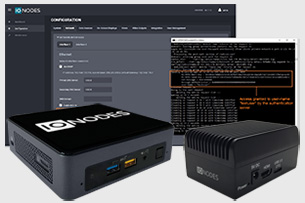News, Secure Display Stations, Technical Article
Mon, November 25 2019

Network security is a key aspect of IONODES’ Secure Display Stations (SDS) line of appliances. This article will focus specifically on the 802.1X feature, available on both the ION-R200, as well as the ION-R100S.
IEEE 802.1X is an IEEE Standard for port-based Network Access Control (PNAC). It is part of the IEEE 802.1 group of networking protocols. It provides an authentication mechanism to devices wishing to attach to a LAN or WLAN.
802.1X authentication involves three parties: a supplicant (client device that wants to attach to the network), an authenticator (the network device that the supplicant directly connects to in order to access the network), and an authentication server.
The authenticator acts like a security guard to a protected network. The supplicant is not allowed access through the authenticator to the protected side of the network until the supplicant’s identity has been validated and authorized. In order to get authorized the supplicant must initially provide the required credentials (username & password) to the authenticator – these will have been specified in advance by the network administrator.
The authenticator forwards these credentials to the authentication server to decide whether access is to be granted. If the authentication server determines the credentials are valid, it informs the authenticator, which in turn allows the supplicant (client device) to access resources located on the protected side of the network.
A simple lab setup is proposed below. A switch with 802.1X functionality will act as the authenticator for an ION-R200 appliance, while the authentication server will be simulated by the software FreeRADIUS.net running on a laptop attached to the same network segment.
Configuration of the authenticator and authentication server will depend on the hardware/software environment used, so please refer to your respective manufacturer(s)/developer(s) for more details.
In our example, we’ve used the following guides:
The user can input the credentials to access the network in the ION-R200’s web management interface Configuration > Network > Ethernet section. The appliance will then provide feedback based on the progress of the authentication process. The message “Authentication Succeeded” should appear once a successful authentication has been completed.
Having secured access to the internal network is a critical point for all deployments in public areas or facilities with few or no trained security staff (like for instance having a spot monitor in a retail shop, healthcare clinic or logistics center).
A malevolent person could physically disconnect the ethernet cable from the Secure Display Station and attach it to his own device in order to instantly gain access to the LAN. With 802.1X authentication, access will only be granted to his device if it supplies the correct credentials, therefore mitigating any risk of rogue/unauthorized users. On top of that, the network admin can easily track and remove individual authenticated users without affecting access for the others on the network. Flexibility and peace of mind, all in one with the Secure Display Stations family of devices from IONODES!
Secure Display Stations product web page: https://www.ionodes.com/securedisplaystation
Access knowledge base articles and create support tickets through our online support portal.
Get SupportReach out to our sales team to learn more about our products and get your projects started.
Contact usSubscribe to our newsletters to receive the latest news on product enhancements, software updates, technical articles, company events and more.
General Newsletter OEM Products Newsletter